I have returned to my Seven Years War period campaign using the 'Soldier King' boardgame: we are in the Summer of 1757, with the Prussians sweeping forward into Austrian territory following their great victory at Rahden, and having expelled the Austrians from the town of Wittingen, albeit at some cost.
 |
| Summer 1757: situation after Wittingen battle |
Roughly translating losses at Wittingen from the Arthur Harman 'SHAME' rules Combat Value (CV) points into Bob Cordery's 'Portable Wargame' Strength Points (SP) values, the Austrians lost the equivalent of only 3 SPs to the Prussians 11 SPs - quite a margin. But most Austrian units were forced to retire, because they took many more 'Falling Flag' hits which lowered morale rather than strength - an interesting feature of the 'SHAME' combat system, and one which seems to ring true, even though just a result of random dice rolls. One could perhaps characterise it as the weaker Austrian force tending to be 'looking over their shoulders' and more easily persuaded to retire faced with more numerous assailants, while the Prussians were confident in their superior strength - perhaps over confident - and prepared to stand more losses without their morale suffering. That's my story, anyway!
So, it was now the Austrian turn in the campaign game, and they rolled three 'marches', so three units/stacks can move - and each unit can move no more than twice. The first priority was to get the two rather isolated infantry units in the western province of Upper Waldow into some sort of safety - so two marches were used, allowing them to join the main body ( recently expelled from Wittingen ) at Zauche. So at least they bolstered the main defence, but the whole army could not then attack - and didn't really feel strong enough to do so, anyway. With one move remaining, what to do? Austrian eyes were drawn to the small detached Prussian infantry force at Piesport - perhaps they could at least do some damage there? Four Austrian cavalry units were within striking distance; an opportunity for a classic cavalry raid, striking at a detachment on the enemy flank. And so, the order was given, and the third Austrian 'march' unleashed the cavalry to attack.
 |
| The Austrian cavalry raid.. |
This is all good fun at the 'strategic' campaign level, but it does leave me with a bit of a conundrum when it comes to the 'tactical' aspect, and how to play out the scenario on the tabletop. We have a small force of line infantry, threatened by a larger force made up of only cavalry. It's certainly not a 'balanced' scenario, to say the least! On the face of it, scary for the Prussians, who are outnumbered two-to-one in units, and they certainly cannot simply withdraw, as they would be overtaken. But it's not all positive for the Austrians - two of their four units are lower-quality 'Levies' ( including the single Heavy Cavalry unit ), whereas the Prussian foot are all 'Veteran'. And if the Prussians simply hunker down behind defences in Piesport town, how can their attackers make any headway against them?
 |
| A very 'unbalanced' fight - or is it? |
I confess I am a little unsure how to play this out. I will be doing a little thinking, looking at scenario ideas and books - I wonder if Donald Featherstone's 'Wargame Campaigns' might give me some hints? One approach might be to think of a range of possible scenarios, from 'Prussians panic and attempt to run for it' to 'Austrians make foolhardy frontal charge' ( with more moderate setups in between ), then decide on the relative likelyhood of each, and let the dice decide? It should be an interesting exercise, albeit probably not crucial to the whole campaign, more a small and entertaining sideshow. I have just enough Austrian Hussars and Cuirassiers to make up the raiding force in 'Portable Wargame' units, so here they are, assembled and ready to move off..
 |
| Daring Austrian raiders |
Of course I'd welcome any reasonable suggestions, hints etc on how to approach this - feel free to comment! I hope to get this played through in the next few days ( which look to be distinctly rainy - I wonder if the 'variable' weather we are having here in England could be incorporated in the game? ). So, back soon with a report, I hope. Meanwhile keep well, and safe, everyone.
**UPDATE** As Neil Patterson pointed out in his really excellent comment, the situation of the town of Piesport is distinguished by its riverside locaiton, so there really should be some 'river crossing' element in the scenario. Here it is on the map:
Thinking cap well and truly on..









